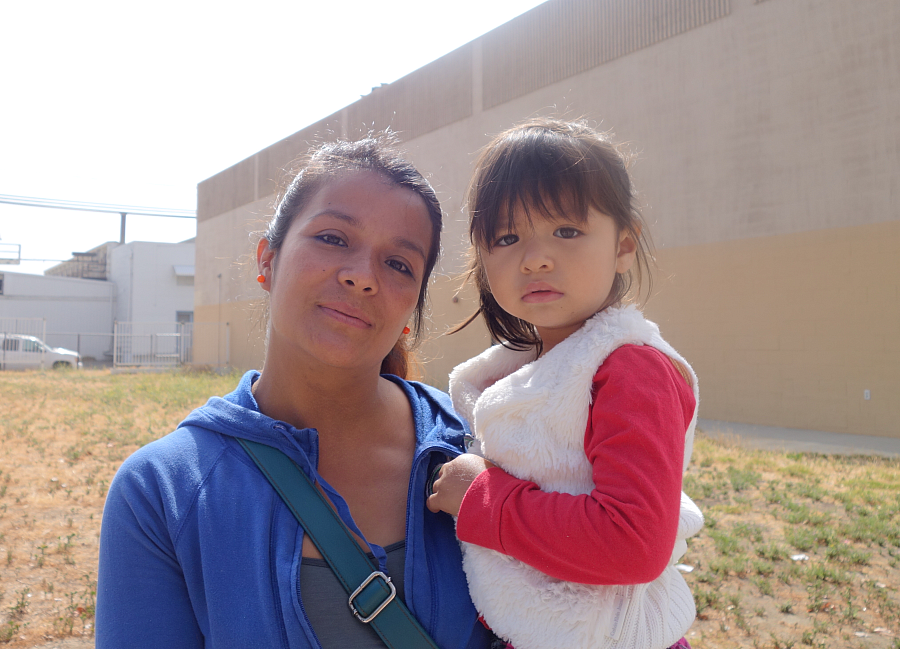A tale of two towns in California’s Ventura County

Maria Martinez and daughter Jackie attend a First 5 free produce giveaway in Santa Paula. (Photo by Kit Stolz)
The story I reported for the California Endowment Health Journalism Fellowship focused on obesity and diabetes in two communities in California’s Ventura County. Though not far apart in terms of distance, the two towns are worlds apart in terms of childhood obesity. Ojai, which is well off, offers a sort of mirror image to Santa Paula to the south, which is one of the poorer towns in the county and has a greater proportion of Latinos. Young people in Ojai are much more likely to be in a healthy weight range, whereas Santa Paula has one of the highest rates of childhood obesity in the state (48 percent).
It took me about six months to bring this story to publication. Given the length of time it consumed, it’s worth getting out of the way a few things that were not helpful.
Although I quoted many numbers in the story, public health databases did not help at all. The spark for the story was lit by a study published by the county’s health care agency in December 2013. The study offered much insight into childhood obesity in the county, but trying to dig further into the data on various online databases – including the one from the county – turned out to be a phenomenal waste of time. The study had already culled the best stats, and even consulting with the statistician for the health care agency didn’t bring me any more useful numbers.
Instead, what I really needed was the human dimension: the personal stories, an understanding of obesity’s causes locally, threats to long-term health, and, most of all, a sense of the actions being taken in Santa Paula to help stem the problem.
If my first mistake was spending too much time looking for good numbers to help guide my effort, my second mistake was looking to the public record for insight into what was going on in Santa Paula. About two-thirds of the inhabitants of Santa Paula speak Spanish at home, according to the Census Bureau, and the town has only one very small newspaper — which is in English. The gap between the public record and what is actually happening on the ground turned out to be a chasm. I found exactly one useful story on this issue online, which came from the county’s daily paper, and that turned out to have been inspired by the fellowship from an earlier year.
My third time-wasting mistake was to trust the institutions that provide health care in Santa Paula (such as the county’s public health care agency) and nutrition (such as the school nutrition program) to respond to a reporter’s inquiries. By contrast, those in similar positions in Ojai, such as the schools’ nutrition director, and the hospital director, were very responsive, and often extremely helpful. The schools’ director of nutrition gave me an hour-plus interview in her office without batting an eye. Administrators in Santa Paula schools, by contrast, simply would not return phone calls, and the county’s health care public information officer, although personally very nice to me, found endless reasons not to offer me access to policy directors or to clinic or hospital waiting rooms in Santa Paula.
After two months of work, all these roadblocks left me with a ton of information and quotes about efforts to reduce the prevalence of obesity in Ojai, and virtually nothing comparable about Santa Paula. (To some extent, this reflected the reality that relatively little had been done in Santa Paula by agencies.)
At the same time, my efforts to dig up new understanding about obesity had born fruit on a national level, after I managed to get interviews with the editor of the journal Childhood Obesity, Dr. David Katz at Yale, and with a diabetes researcher at the CDC, Edward Gregg.
This brings up a strange irony. For a reporter who knows what he’s looking for, it can be easier to get an interview with a nationally known expert than with a local small-town bureaucrat. The trick seems to be to find the subject that the nationally known expert wants to talk about – ideally a new study he just released – and then use the time on the phone craftily, asking a few questions about what you’re trying to understand, even if that’s not the stated purpose of the call. The nationally known experts turned out to be hugely helpful, both in understanding my topic and focusing my efforts.
Interestingly, local health care providers in Santa Paula – at health care clinics, at First 5 offices, and at local nonprofits – were often willing to help and to introduce me to locals who had stories to tell. Trying to go through official channels to reach these folks turned out not to be necessary. Calling up a clinic directly and politely asking questions about a specific topic turned out to be all that was required. I only had one case in which a clinic director asked that I submit questions via email, which she passed on to a doctor and asked that he return my call.
His return call – in which he confirmed that his patients where broadly reflective of the statistics in Santa Paula – provided me with the story’s capstone quote. And it came from one last random call made out of a sense of desperation, with little expectation of success.
On reflection, my advisor Martha Shirk said that this was something she had learned over years and years of reporting. Simply put, it’s often the very last call that gives you what you need to bring the story home. To which I can only add, Amen.
